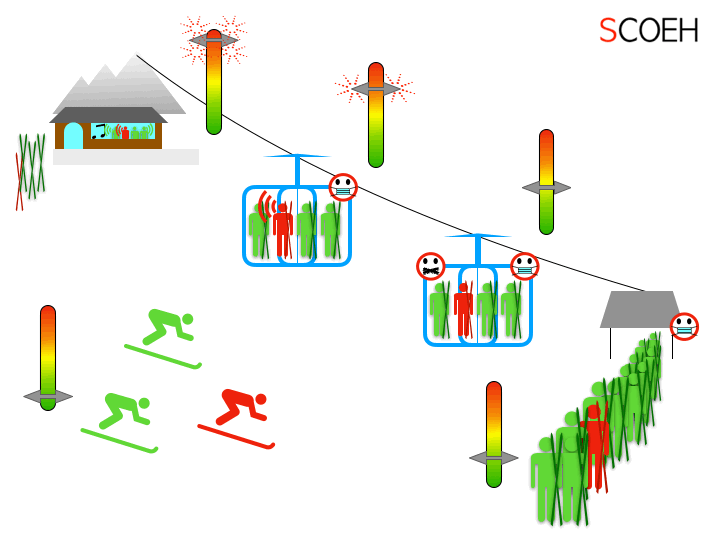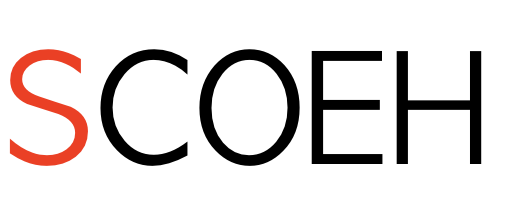If you decide to go ski this winter, be quiet. No, it’s not about not telling your government that you decided to go skiing. It’s about not creating sounds with your mouth. Combined with masks, it is the best way to prevent a series of super-spreading events. Do this if you want the skiing resorts to stay open for the entire season.
Winter has arrived and so did a second wave of the Corona-disease. The cold temperatures let people gather in small rooms with closed windows rather than in the wide outdoors, which contributes to the spread of the disease. With winter comes also snow and the desire to go skiing. But is it safe? The debates are heated and governments take actions that go from asking people to mask up to prohibiting skiing all-together. But what does science tell us? Let’s look at some of the strategies:
First strategy: Close the ski resort. No skiers means nobody getting infected. Let’s just hope that the people don’t use the time to meet many friends indoors in their home town. But if again you limit how many can meet, you can reduce the spread of the disease. Though this approach is radical, it will work.
Second strategy: Wash hands, keep distance and mask up if distances are short. Aerosol can accumulate in small rooms. The mask and the distances will protect only from sprayed droplets but not from aerosol accumulation in rooms. One loud super-emitter in a restaurant or cable cabin will be sufficient to infect many. This approach will fail because it ignores aerosol science.
Third strategy: Mask up, ventilate well, limit contact time with others and tell people to be quiet. The masks will catch the large droplets and some of the aerosols. Asking people to be quiet reduces the aerosol emissions of everybody, including those of the rare super-emitters. By limiting the time together, we reduce the build-up of aerosols. This approach can work if correctly implemented.

Background
The epidemiological situation makes it likely that several super-emitters will be amongst those going to ski this winter. We can now look at the places such a person will be in proximity of others. I assume this super-emitter is wearing a„simple cloth“ and most of the others also wear the same type of mask. The following table shows the virus dose of the exposed people inside micro-environments, calculated with the Indoor Scenario Simulator.
| Location | No. people | Duration | Air exchange per hour | Inhaled Dose, talking 50% loud (far to near-field) | Inhaled Dose, all quiet (far to near-field) |
| Breakfast room, no mask (250 m3) | 50 | 30 Minutes | 1 | 2,517 to 6,389 viruses | 51 to 130 viruses |
| Same but good ventilation | 50 | 30 Minutes | 6 | 1,379 to 5,250 viruses | 28 to 106 viruses |
| Waiting hall cable-car (1000 m3) | 200 | 20 minutes | 1 | 173 to 1,625 viruses | 4 to 33 viruses |
| Large cable-car cabin (75 m3) | 120 | 10 minutes | 0.1 | 693 to 1,419 viruses | 14 to 28 viruses |
| Same, but windows open | 120 | 10 minutes | 6 | 508 to 1,234 viruses | 10 to 25 viruses |
| Small cable-car cabin (8 m3) | 6 | 10 minutes | 0.1 | 6,494 to 7,220 viruses | 132 to 146 viruses |
| Same, but windows open | 6 | 10 minutes | 6 | 4,765 to 5,491 viruses | 97 to 111 viruses |
| Après-ski restaurant, no masks (250 m3) | 100 | 180 minutes | 1 | 37,123 to 60,353 viruses | 752 to 1,224 viruses |
| Same, but good ventilation | 100 | 180 minutes | 6 | 10,870 to 34,099 viruses | 220 to 691 viruses |
The spreading-spree of the loud super-emitter
Now let’s combine this data to simulate a typical skiing day of a loud (or quiet) super-emitter and let’s look at how many people get infected in these micro-environments. Above a dose of 500 viruses, the infection risk increases, at 5000 viruses, it is already very high.
Loud super-emitter:
Breakfast:
49 cases in breakfast room get an elevated dose, about 25 of these get sick.
Going up the mountain with the large cable-car:
2 people in the near-field in waiting hall have elevated dose, 1 gets sick.
119 people in the large cable car get high dose, 60 get sick.
Skiing in the mountain:
The super-emitter takes ten times a small cable car:
10 x 5 =50 people in the small cable car get a very high dose, 40 get sick.
Après-Ski:
99 people in restaurant get extreme dose, 99 get sick.
Total per skiing day: 225 sick. Thus, in one week, 1,575 sick.
Quiet super-emitter:
Breakfast:
0 cases in breakfast room have elevated dose, 0 get sick.
Going up the mountain with the large cable-car:
0 people in the near-field in waiting hall have elevated dose, 0 get sick.
0 people in the large cable car have elevated dose, 0 get sick.
Skiing in the mountain:
The super-emitter takes ten times a small cable car:
10 x 0 people in the small cable car have elevated dose, 0 get sick.
Après-Ski:
99 people in restaurant get border-line dose (if ventilation not good), 5 get sick.
Total per skiing day: 5 sick. Thus, in one week, 35 sick.
Conclusion
We see the effect of asking people to be quiet. If all put on a mask and stay quiet when indoors, skiing will be possible in a fairly safe way. The place where people still get infected is the evening restaurant. So, if restaurants want to stay open, they should ask guests to be quiet, limit the time they spend in the place (e.g. to 30 to 60 minutes), and ventilate well (plus staff must wear a good mask). This actually applies also to the restaurants outside the skiing resorts.
